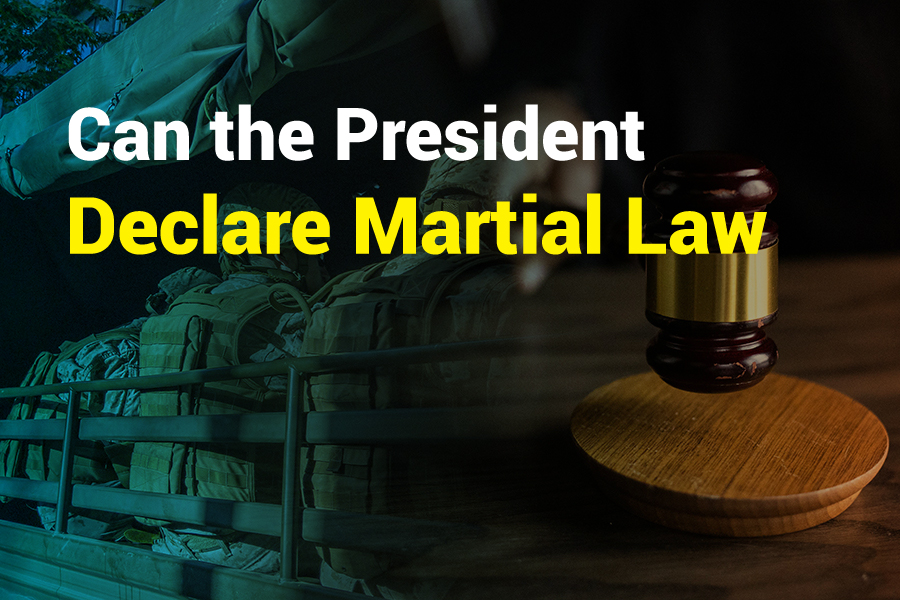In times of national crisis or societal upheaval, the question of whether the President possesses the authority to declare martial law looms large, sparking debates that delve deep into the heart of constitutional interpretation and the delicate balance of powers within the American government. Such discussions are not merely theoretical exercises but hold profound implications for the very fabric of democracy, touching upon themes of individual freedoms, the rule of law, and the limitations of executive authority.
To unravel this complex issue, we must embark on a journey through legal doctrines, historical precedents, and the evolving landscape of governance in times of turmoil. By exploring the intricacies of presidential powers in the context of martial law, we aim to gain a nuanced understanding of how the nation grapples with crises and the mechanisms through which its leaders navigate the delicate intersection of security and civil liberties.
Can The President Declare Martial Law?
Yes, the President of the United States has the authority to declare martial law under certain circumstances. However, this power is not absolute and must be exercised within the confines of the Constitution and existing laws. Martial law can be declared in response to significant threats to public order, such as natural disasters, civil unrest, or wartime emergencies. It essentially grants the military temporary authority to maintain law and order, suspend certain civil liberties, and enforce government regulations.
Understanding Presidential Powers
The authority of the President to declare martial law is deeply rooted in the constitutional framework of the United States. Central to this authority is the President’s role as the head of the executive branch and Commander-in-Chief of the armed forces, as outlined in Article II of the Constitution. This grants the President significant discretion in matters of national security and emergency response.
Under the Constitution, the President is empowered to take decisive action to protect the nation from threats both foreign and domestic. This includes the authority to deploy military forces, suspend certain civil liberties, and implement emergency measures when deemed necessary for the preservation of public order and safety. However, the framers of the Constitution also established a system of checks and balances to prevent the concentration of power in any one branch of government.
One key limitation on presidential authority to declare martial law is the principle of federalism, which delineates the respective powers of the federal government and the states. While the President may have authority over federal territories and military installations, the enforcement of martial law within the borders of a state typically requires the cooperation or consent of state and local authorities.
Moreover, the Constitution imposes constraints on the duration and scope of martial law declarations. The suspension of constitutional rights and liberties is permissible only to the extent necessary to address the immediate crisis or threat at hand. Any attempt to abuse or exceed these powers may be subject to legal challenge and judicial review.
Instances Of Martial Law Declarations
Throughout American history, there have been several notable instances where presidents have declared martial law in response to crises, emergencies, and threats to public order. These declarations provide insight into the circumstances under which martial law has been invoked, as well as the legal and societal implications of such actions.
Civil War Era:
One of the most significant periods of martial law declarations in American history occurred during the Civil War. President Abraham Lincoln, facing the secession of Southern states and the outbreak of hostilities, declared martial law in several states, including Maryland, Kentucky, and Missouri. Martial law was used to suppress dissent, maintain control over key transportation routes, and enforce conscription orders. The suspension of habeas corpus during this time allowed for the arrest and detention of individuals deemed to be a threat to national security.
Reconstruction Period:
Following the end of the Civil War, martial law continued to be enforced in some Southern states during the Reconstruction era. Military governors appointed by the federal government oversaw the implementation of martial law in states such as South Carolina and Louisiana, where the presence of armed resistance and racial tensions persisted. Martial law was used to quell violence, protect newly freed African Americans, and enforce federal reconstruction policies aimed at restoring order and stability in the South.
Labor Strikes And Civil Unrest:
In the late 19th and early 20th centuries, martial law was declared in response to labor strikes and civil unrest in several cities across the United States. One notable example is the Pullman Strike of 1894, during which President Grover Cleveland deployed federal troops to break up the strike and restore rail service. Martial law was also declared during the Colorado Labor Wars of 1903-1904 and the West Virginia Coal Wars of 1920-1921, where clashes between labor unions, mine owners, and law enforcement led to widespread violence and instability.
World War II And National Security:
During World War II, martial law was declared in Hawaii following the attack on Pearl Harbor in 1941. The military government assumed control of the islands, imposing curfews, censorship, and restrictions on civil liberties in the name of national security. Similar measures were enacted in the Aleutian Islands of Alaska, where martial law was declared in response to fears of Japanese invasion.
Civil Rights Movement:
In the 1960s, martial law was declared in response to civil rights protests and racial unrest in several cities, including Detroit, Newark, and Los Angeles. President Lyndon B. Johnson deployed federal troops to restore order and quell riots sparked by racial tensions and police brutality. Martial law was used to enforce curfews, disperse crowds, and restore public safety amid widespread unrest.
Limits On Presidential Authority
While the President possesses the authority to declare martial law under certain circumstances, this power is not absolute and is subject to legal and judicial oversight. The Constitution and federal statutes establish constraints on the exercise of presidential authority, particularly in matters related to the use of military force for domestic law enforcement purposes.
Posse Comitatus Act: One of the primary legal limitations on presidential authority to declare martial law is the Posse Comitatus Act of 1878. This federal law prohibits the use of the military for civilian law enforcement activities within the United States, with certain exceptions. The Posse Comitatus Act was enacted in response to concerns about the use of federal troops to suppress civil liberties and political dissent during the Reconstruction era. While the Act does allow for limited exceptions, such as in cases of insurrection or natural disaster, it generally prohibits the deployment of military forces for domestic law enforcement purposes without congressional authorization.
Insurrection Act: The Insurrection Act of 1807 provides another legal framework governing the use of federal military forces to suppress domestic insurrections, rebellions, and other forms of civil unrest. Under the Insurrection Act, the President may deploy the military to enforce federal laws and protect public safety when state or local authorities are unable or unwilling to do so. However, the Act imposes strict limitations on the circumstances under which the President can invoke martial law, requiring a formal proclamation declaring the existence of an insurrection or rebellion before military intervention is authorized.
Constitutional Constraints: Beyond statutory limitations, the President’s authority to declare martial law is also subject to constitutional constraints. The Fifth Amendment guarantees due process rights, including the right to a fair trial and protection against arbitrary government action. The Fourth Amendment protects against unreasonable searches and seizures, while the First Amendment safeguards freedom of speech, assembly, and petition. Any attempt to suspend or infringe upon these constitutional rights through the declaration of martial law would likely be subject to legal challenge and judicial review.
Judicial Review: The judiciary serves as a crucial check on presidential authority, with the power to review the constitutionality of executive actions, including martial law declarations. Courts have the authority to scrutinize the legality of martial law orders, assess whether they comply with constitutional standards, and provide remedies for violations of individual rights. Judicial review ensures that presidential actions are consistent with the rule of law and the principles of separation of powers, preventing the abuse of executive authority and safeguarding the rights of citizens.
Balancing Security And Civil Liberties
At the heart of the question of whether the President can declare martial law lies a broader ethical and democratic dilemma: how to balance the imperative of national security with the protection of civil liberties. The declaration of martial law represents a significant expansion of executive authority, with implications for individual rights, democratic norms, and the rule of law. Striking the right balance between security and civil liberties requires careful deliberation, robust legal safeguards, and a commitment to upholding democratic principles even in times of crisis.
Preservation Of Civil Liberties: Upholding individual rights such as freedom of speech and due process is essential even during martial law. Any suspension of these rights must be legally justified and subject to strict scrutiny.
Rule Of Law: Martial law should adhere to clear legal standards and be subject to judicial review to prevent abuse of power and maintain democratic integrity.
Proportionality And Necessity: The use of martial law should be limited to situations of imminent threat to public safety, and its scope should be proportional to the crisis at hand to prevent excessive government overreach.
Public Accountability And Oversight: Transparency, congressional oversight, and judicial review are vital for ensuring that martial law declarations remain accountable to democratic principles and protect civil liberties.
Conclusion
The question of whether the President can declare martial law is not merely a matter of legal interpretation but one that delves into the very essence of democratic governance. It challenges us to reconcile the imperative of national security with the fundamental principles of individual rights and the rule of law.
As we navigate this complex terrain, it is imperative to maintain a steadfast commitment to upholding constitutional liberties, ensuring transparency and accountability in executive actions, and upholding the principles of necessity and proportionality. By adhering to these principles, policymakers can navigate the challenges of martial law declarations with integrity and fidelity to democratic values, thereby safeguarding the rights and freedoms of all citizens, even in the face of adversity.
FAQ’s
When Was Martial Law Declared In Poland?
Martial law was declared in Poland on December 13, 1981, by the Communist government to suppress the Solidarity movement.
How Old Is Marshall Law Tekken?
Marshall Law, a character in the Tekken video game series, is typically depicted as being in his late 40s or early 50s.
Is Marshall Law Tekken Chinese?
No, Marshall Law is not Chinese. He is a fictional character from the Tekken video game series, created by Japanese game developer Namco.
Robert Stewart is a seasoned law blog writer with a passion for translating complex legal concepts into accessible, informative content. With a keen eye for detail and a knack for storytelling, Robert crafts engaging articles that educate and empower readers in the realm of law.
Drawing upon his extensive experience in the legal field, Robert brings a wealth of knowledge to his writing, covering a diverse range of topics including personal injury, family law, criminal defense, and more. His articles combine thorough research with clear, concise language, making them valuable resources for both legal professionals and laypeople alike.


